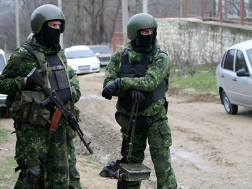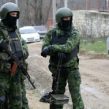
Security Services’ Puzzling Hyperactivity in North Ossetia May Be Connected to Sochi Olympics
Publication: Eurasia Daily Monitor Volume: 10 Issue: 72
By:

A surprising series of counter-terrorist operations in North Ossetia were launched in the spring of 2013. On March 4, a counter-terrorism operation regime was introduced in three villages—Tarskoe, Verkhny Komgaron and Nizhny Komgaron. All three are located in the southeastern part of the republic, bordering Ingushetia. Apart from ethnic Ossetians, there are also ethnic Ingush in this part of the republic. The counter-terrorism operation regime envisioned restricting access to certain areas and spot checks of people’s documents and vehicles (https://ria.ru/defense_safety/20130304/925623041.html). The counter-terrorism operation regime in the area was partially lifted only on March 16, nearly two weeks after it started. The stated reason for introducing the special regime was for “the neutralization of the activities of the bandit underground in the North Caucasus and prevention of infiltration of bandit units into the territory of the republic” (https://ria.ru/defense_safety/20130316/927603850.html#ixzz2QO9O8pe8). At the end of these strenuous counter-terrorist activities, all that the security services could claim as a success was having located a large cache of ammunition. The cache was found near the North Ossetian village of Sunzha, which is also near the administrative border between North Ossetia and Ingushetia (https://ria.ru/incidents/20130321/928441886.html). However, since the security services in the North Caucasus are known for planting ammunition caches in order to “find” them later, the claim may have been fictitious.
On April 8, a counter-terrorism operation regime was declared in the village of Kizlyar in the northernmost district of North Ossetia, Mozdok, but it was lifted after only one day. No tangible results of the special operation were made known: the security services simply asserted in a brief statement that they had prevented insurgents from infiltrating North Ossetia (https://www.kavkaz-uzel.ru/articles/222599/). The village of Kizlyar, with over 8,000 residents, is the largest and oldest village in Mozdok district. Kizlyar is populated by Turkic-speaking ethnic Kumyks who also live in southeastern Stavropol region, northern Chechnya and northern Dagestan. Mozdok district as a whole is the only district in North Ossetia where ethnic Russians are a majority—slightly over 50 percent. However, they are moving out in increasing numbers, and being replaced by Ossetians, Chechens, Ingush and other North Caucasians.
On April 10, a counter-terrorism operation regime was unexpectedly announced in the forested areas near the North Ossetian villages of Batako and Razdzog, along the administrative borders with Ingushetia and Kabardino-Balkaria south of Mozdok district. This time, the Russian security services said that the special regime was designed “to identify and eliminate the bandit underground support base and members of the bandit group, to prevent terrorist attacks that are being prepared, minimize their consequences, as well as to protect vitally important objects” (Interfax, April 10). The counter-terrorism regime in this area yielded no results—not even ammunition caches were found.
On April 12, a counter-terrorism operation was declared in two villages of Mozdok district, Kusovo and Khurikau (https://ria.ru/defense_safety/20130412/932383452.html).
Thus, within a month’s time, counter-terrorism operation regimes were introduced in North Ossetia four times, in four very different areas of the republic, although they were all near the border with Ingushetia, Kabardino-Balkaria and Chechnya. They yielded no tangible results except the dubious discovery of a large ammunition cache.
The question is what triggered the proliferation of counter-terrorism operations in North Ossetia, where there is no known armed underground movement. The republic borders Ingushetia, Chechnya and Kabardino-Balkaria, where the security situation is precarious, but when the situation in these republics was even worse, no counter-terrorism operation regime was normally introduced on the North Ossetian side of the administrative border.
The most likely explanation for the spike in activities of security services in North Ossetia is that it is part of the Russian security services’ preparations for the Olympics in Sochi. Apparently, the authorities decided to implement counter-terrorism regimes anywhere they sense even the remotest threat. So far the security services have not affected the locals in North Ossetia in adverse ways. However, it is not hard to foresee that if the zeal of the government agencies prevails, they might easily start identifying “insurgent sympathizers” in North Ossetia, which is host to ethnic Chechens, ethnic Ingush and other Muslim ethnic groups, as well as the portion of ethnic Ossetians who are themselves Muslims.
The security services’ zeal is not unknown in the North Caucasus in general and in North Ossetia in particular. On April 2, two females from Dagestan were sentenced to two years in prison for allegedly carrying an improvised explosive device (IED) (https://www.kavkaz-uzel.ru/articles/222315/). Zalina Gabibulaeva and Zaira Akaeva were arrested at the administrative border between North Ossetia and Ingushetia while they were on their way from Dagestan to Kabardino-Balkaria. Initially, anonymous law enforcement sources refuted claims that the arrested women were implicated in any crimes. The only “crime” Gabibulaeva and Akaeva apparently had committed was that they wore the hijab, which alerted and antagonized the North Ossetian police. The police also claimed that the arrested individuals were widows of slain rebels (https://north-osetia.kavkaz-uzel.ru/articles/205796/).
As the Olympics in Sochi approach, the zeal of the security services is likely to increase. In the process, however, they could easily cross the red line and create hot spots of instability in areas that otherwise have few preconditions for this.




